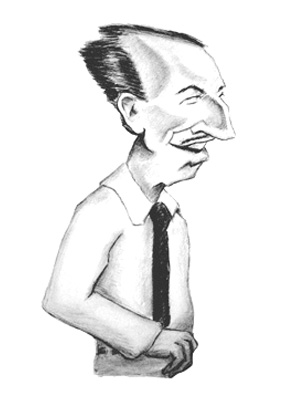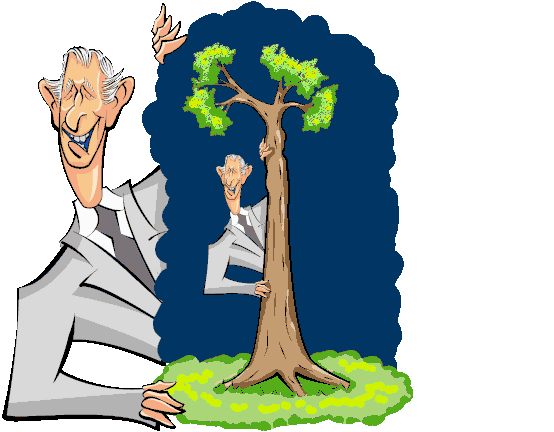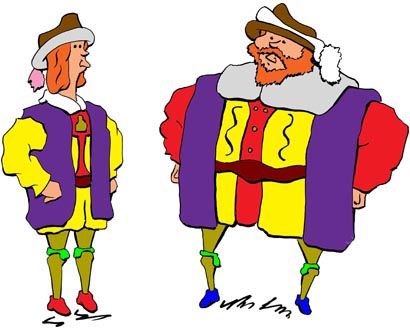The Merry House
of Windsor

(Click to Zoom In and Out)
And of course Elizabeth II, by the Grace of God, of the United Kingdom of Great Britain and Northern Ireland and of Her Other Realms and Territories Queen, Head of the Commonwealth, Defender of the Faith, married Phillip Mountbatten on November 20, 1947. Of course, at that time Elizabeth was still Princess Elizabeth. Phillip's dad was Prince Andrew of Greece and Denmark and his mom was Princess Alice of Battenberg which is part of the modern German state of Hesse. So Phillip was Prince Phillip of Greece and Denmark.
Phillip and his dad were indeed born in Greece. But Alice was born in England - in Windsor Castle, no less. We won't bother explaining the complex familial relationships that made it perfectly natural for Prince Phillip of Greece and Denmark to become Phillip Mountbatten, Duke of Edinburgh. But we will remind residents of Pittsburgh, Plattsburgh, and Newburgh that Edinburgh is not - that's NOT! NOT! NOT! - pronounced ED-in-berg.1
Footnote
Lest the Good Citizens of Harrisburg raise umbrage about the omission of their good city despite it's many merits - they have a great museum - there is no "h" at the end.
Unfortunately, the actual pronunciation seems to be a subject of some controversy. According to one high-falutin' source, the word Edinburgh has four syllables and the pronunciation is officially written as ED-in-bər-ə. The upside down "e", ə, is called a schwa and is what linguists call an "unaccented neutral vowel". For all practical purposes a schwa is a quickly spoken and relative quiet "uh" sound. So by this criteria Edinburgh should be pronounced something like ED-in-bur-uh but where you kind of hurry the last two syllables.
However, there are those who say there are only three syllables! And the proper pronunciation is ED-in-brə which is spoken something like ED-in-bruh. This three-syllabic pronunciation is vouched for by many, but on the other hand, no less an authority than Walt Disney went on record - and on his television show Disneyland - to opt for four syllables as ED-in-bur-ro as in the donkey.
But how do we resolve this conundrum of pronunciation? We've always wanted to know that.
No doubt you have, as Captain Mephisto said to Sidney Brand. It's very simple really.
First of all, we should ask just what the Scots say. And one native Scots speaker has written that just like tuh-MAY-toh or tuh-MAH-toh, you can say what you like. ED-in-bruh or ED-in-bu-ruh it's all the same.
Quite literally, the two pronunciations are the one and the same. That's because it simply boils down to how you pronounce "r". If you use the standard English or (ugh!) American pronunciation, the simplest way to pronounce the 18th letter is to say AH but lift the tip of the tongue up toward but not touching the roof of the mouth. This produces the unique "r" sound that according to some ESL students makes English sound like two cats fighting.
Exactly where the tip of the tongue is positioned depends on the dialect - British, American, Southern, Boston, etc. It can be close to the ridge just back of the front upper teeth - the alveolus - producing what linguistic professors call a "alveolar approximant". Or the tip can be positioned further back which then sounds a "post-alveolar approximant". At the same time you vibrate the vocal cords and so "r" is also a voiced consonant.
But let's go to other ways of speaking English - like in Scotland. Some people there pronounce "r" in a manner related to Spanish which has the "double r" where the tongue is "trilled" or rolled against the alveolus (listen to a native speaker pronounce "burro"). But for the Spanish "single r" - as in "toro" - the letter is just a quick tap or "flap" of the tongue. And some Scots speakers pronounce "r" with a similar tongue tap.2
Footnote
Phonologically, the r pronounced in standard English is a semi-consonant or liquid.
A consonant is a sound that interrupts the flow of air. If you pronounce a word with a "pure" consonant like "b", "k", "p", or "t", the flow of air is actually stopped between the vowel sounds.
But the "standard English r" doesn't stop the air but modifies the vowel to provide a transition to another vowel. But note that the Spanish or Scottish "tap r" does produce a brief interruption of the air and so is a true consonant.
So now try to pronounce ED-in-bruh with the three syllable pronunciation but the tapped "r" as ED-in-b'ruh. Notice that when you say it, by golly, it comes out just like you're saying ED-in-bu-ruh.
So it seems the three vs. four syllable preference is simply a matter de dialectis. And in matters de dialectis, just as in matters de gustibus, non est disputandum.
But NEVER, we're told, say ED-in-burro à la Walt.
Elizabeth Windsor became Queen of England on February 6, 1952, when she was only 25 years old and her coronation was on June 2. She was the second monarch to bear the name, and her early nickname Lilibet was a good way to avoid confusing her with the first Elizabeth who was stylized Good Queen Bess. England's current monarch, King Charles - Elizabeth's oldest son - is only the third king of that name.
As far as what is the most popular royal appellation, that's either Henry or Edward with eight monarchs each. In addition there have been six Georges, four Williams, three Richards, and two Jameses, and two Marys. Unique names for the monarch (so far) are John, Anne, Stephen, and Victoria. Victoria, of course, was the Queen of England who established the Empire on Which the Sun Never Set.
Curmudgeons may look at the flag in the above picture and think it's a poorly crafted digital image of the Union Jack, the national flag of the United Kingdom. After all, look at the stripes! They don't line up and where they meet up with the flag's edges isn't consistent. Why the flag itself isn't even symmetrical!
Actually, the Union Jack - where the name comes from isn't quite clear - isn't symmetrical and the slight up and down displacement of the red diagonal lines is part of the design.
The reasons are straightforward. The Union Jack is the combination of the crosses of St. George (white vertical and horizontal bands), St. Andrew (white diagonal cross), and St. Patrick (red diagonal cross) to represent respectively England, Scotland, and Ireland. St. Patrick's Cross was added after St. Andrew's, but putting St. Patrick's Cross in full size would cover up St. Andrew's. So the designers reduced St. Patrick's in width and offset the lines, perhaps figuring that since St. Patrick's Cross has to be superimposed on top the St. Andrews's Cross, having it a thinner and offset evens things up.
However, the flag does maintain rotational symmetry. That is if you turn it 180 degrees it looks the same. But the design does mean the Union Jack CAN inadvertently be flown upside down.
The correct side up is where the wider white area of St. Andrew's Cross above the red diagonal is oriented on the left, that is, nearest the flagpole. Also if the flag is to be displayed on a flat surface it should also have the same set-up. If the flag is to be shown hanging downwards, it should be rotated 90 degrees clockwise.
A surprise for people looking for examples of the Union Jack is when they find the  Union Jack! This is a flag which is simply the blue field with the stars of the American flag. First adopted in 1771 this was - count 'em - thirty years - count 'em - BEFORE the British Union Jack was made official.
Union Jack! This is a flag which is simply the blue field with the stars of the American flag. First adopted in 1771 this was - count 'em - thirty years - count 'em - BEFORE the British Union Jack was made official.
A "jack" is a flag flown from the bow of a ship when it's docked. So although it's not really known where the name for the British Union Jack originated, a good guess is it was first used as a mooring flag for His/Her Majesty's Ships before becoming the national flag.4
Footnote
Nor will it escape notice of the discerning reader that the American Union Jack was adopted a full THIRTY YEARS before the British Union Jack.
Unlike its British counterpart, the American Union Jack does have horizontal symmetry so there isn't any way to fly the flag reversed. But because the stars are of the five-pointed design it is possible to inadvertently fly it upside down.
Queen Elizabeth was the longest ruling English monarch and her reign of 70 years extended seven years past the duration of that of Queen Victoria's (Drina to her friends). Of course, who was the longest monarch in history is a matter both of definition as who is or isn't a monarch and of the type of documentation accepted.
The longest recorded reign of any king or queen in modern times for which there is irrefutable evidence was, of course, that of Louis XIV of France, the "Sun King". But he only ruled two years longer than Elizabeth who holds the records for queens who ruled without an accompanying king.
Although the reign of Elizabeth II had its ups and downs, all in all she was one of the most popular rulers of England. How to decided if she was THE most popular monarch is an undecidable question as historians don't always agree and also tend not to make the same lists as your average Joe and Josephine Blow on the street.
Of course, there's a difference between "Most Popular", "Best", and "Most Famous". One ruler who has been listed as #1 in all three categories was Queen Elizabeth I. The Most Famous/Least Popular Award probably goes to Henry VIII who started out OK but who along with his reign rapidly went downhill.
As far as who heads the list of the Biggest Jerk to Sit On the English Throne, this is almost always designated to be King John. Ironically the worst King of England is also one of the most famous as he is cited for his signing the Magna Carta in 1215. However, strictly speaking King John did not sign the document but only affixed his seal.
So no, on the Magna Carta there is no King John Hancock.
References
"Union Jack", ROYAL.UK.
"Flying flags: A Plain English Guide", GOV.UK.
"UK Flag Protocol", Flag Institute.
"What Happened on November 20, 1947?", On This Day.
"Edinburgh", Cambridge Dictionary.
"Edinburgh" Pronunciation. Stop Saying It WRONG!", Speak Well.
"Scots Pronunciation Guide", Katrina Patrick, The Scots Magazine
"Most Common Names of English Monarchs Since 1066 Stats", Sporcle.
"'Lilibet' Isn't the Queen's Only Nickname! 10 Other Surprising Royal Family Pet Names", Phil Boucher, People Magazine, June 9, 2021.
"r Sound: How to Pronounce the r Sound (/r/ Phoneme)", Colin Munro, English Language Club, September 6, 2021.



